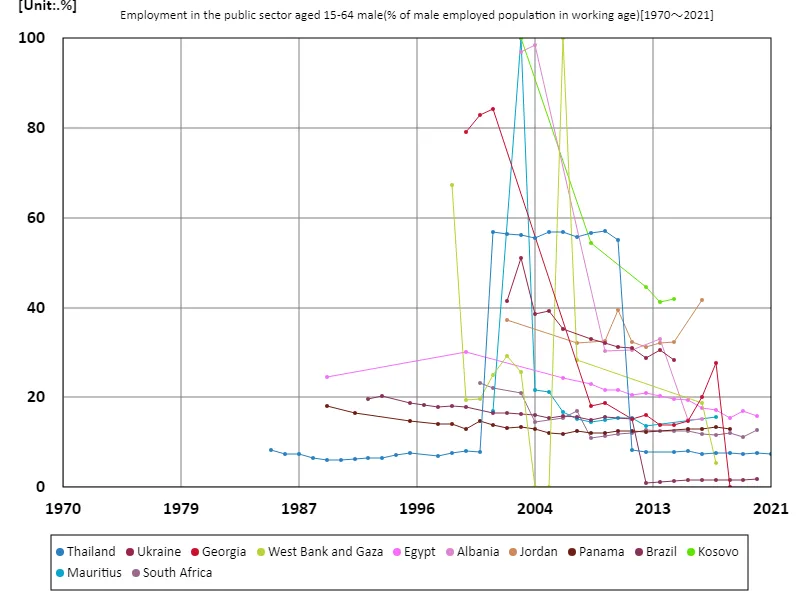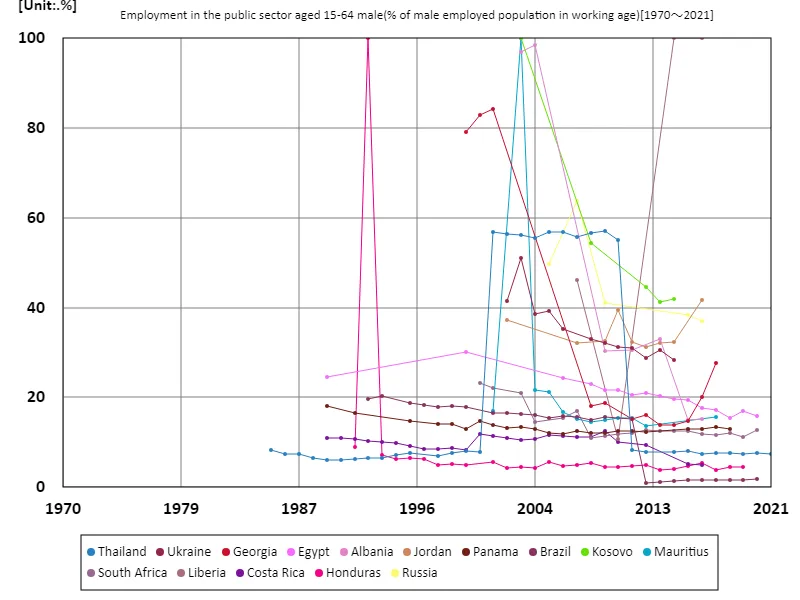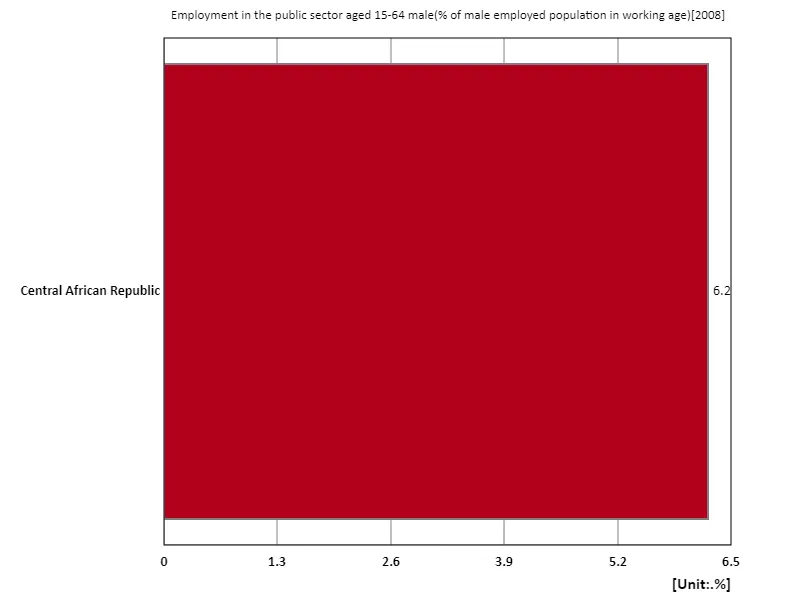- Abstract
- Employment rate in the public sector for men aged 15-64 (percentage of working-age men in the working population)
- Public sector employment rate for men aged 15-64 (percentage of working-age males in the labor force) (Worldwide)
- Public sector employment rate for men aged 15-64 (percentage of working-age males in the labour force) (world, latest year)
- Employment rate in the public sector for men aged 15-64 (percentage of working-age males in the labour force) (region, latest year)
- Reference
Abstract
Public sector employment rates reflect the size of each country’s government, the quality of public services, and the impact of policies. The reason why Thailand recorded the highest public sector employment rate for men aged 15-64 in 2021 at 7.51% may be due to the Thai government’s high reliance on the public sector. Thailand’s public sector aims to improve public services and social security, and is believed to be securing a large number of human resources for this purpose. In contrast, many other countries tend to have relatively low public sector employment rates amid a growing private sector and shrinking government. Understanding these trends allows us to delve deeper into the differences in economic structures and policies across countries.
Employment rate in the public sector for men aged 15-64 (percentage of working-age men in the working population)
Looking at public sector employment rate data from 1985 to 2021, the fluctuations in Kosovo are particularly noteworthy. In 2003, the public sector employment rate for men aged 15-64 was an unusually high 100%, because Kosovo was in a period of post-war reconstruction and the public sector was almost the only source of employment. As Kosovo’s economic situation stabilises and the private sector develops, public sector employment has now fallen to around 42%. This shift marks a move away from over-reliance on the public sector and towards economic diversification and private sector growth. Similar trends are emerging in other countries, particularly developed economies, which are seeing a decline in public sector employment and a shift towards more private sector-led economic structures. In countries with high public sector employment rates, the expansion of public services and government-led economic measures play an important role, but in the long term, the private sector will need to expand along with economic growth. The case of Kosovo illustrates the impact that rapid changes in the economic environment can have on employment structure, and highlights the importance of a balance between the public and private sectors.


The maximum is 100%[2003] of Kosovo, and the current value is about 42%
Public sector employment rate for men aged 15-64 (percentage of working-age males in the labor force) (Worldwide)
In terms of public sector employment rates from 1985 to 2021, Honduras recorded an outstanding value of 100% in 1992, indicating that the public sector accounted for almost the entire labor market. This was at a time when Honduras was experiencing economic crisis and political turmoil, with the public sector acting as the main source of employment. Since then, Honduras’ public sector employment rate has fallen dramatically, currently standing at a peak of 4.45 percent. This change is the result of economic liberalization, the expansion of the private sector, and public sector efficiency policies. Honduras has shifted from the public sector to the private sector and diversified its economy, with the majority of jobs moving to the private sector. This trend can be seen in many other countries, particularly those undergoing economic reform, where public sector employment tends to fall and the private sector grows. Excessive public sector employment can be a financial burden, so many countries are looking to make the public sector more efficient and promote the private sector. The changes in Honduras provide an important example of how economic reforms can affect the structure of public sector employment.


The maximum is 100%[1992] of Honduras, and the current value is about 4.45%
Public sector employment rate for men aged 15-64 (percentage of working-age males in the labour force) (world, latest year)
Data for 2021 shows that Ethiopia has the highest public sector employment rate among men aged 15-64 at 49.5%. This indicates that Ethiopia’s public sector plays a very important role in the economy, a trend that is common especially in developing countries and countries where policies emphasize government-led economic management. As the overall average of 16.3% shows, public sector employment is relatively low in many countries, with the private sector being the main source of employment. This trend is particularly evident in developed and mature economies, as public sectors become more efficient and private sectors grow. The total figure of 81.7% indicates that although public sector employment is relatively low worldwide, in developing and certain countries the public sector is an important source of employment. A high public sector employment rate is related to the role of government, the quality of public services, and the stage of economic development, and depends heavily on each country’s economic policies and social structure.


The maximum is 49.5% of Ethiopia, the average is 16.3%, and the total is 81.7%
Employment rate in the public sector for men aged 15-64 (percentage of working-age males in the labour force) (region, latest year)
In 2008 data, the overall public sector employment rate for men aged 15-64 in agriculture and primary occupations was a uniform 6.23%. This figure indicates that public sector employment in agriculture and primary occupations is relatively uniform and distributed evenly across countries. Developing countries show that the public sector provides some employment opportunities in agriculture and primary occupations, as seen in the Central African Republic, which recorded the highest rate at 6.23%. In these countries, the public sector plays a key role through the provision of basic services such as agricultural support and primary education. Formal sector employment is especially important in areas whose economies depend on agriculture and primary occupations. On the other hand, in developed countries and areas with diversified economies, the public sector has relatively little involvement in agriculture and primary vocational education, which tends to be led by the private sector. This causes the overall average and total to converge to a certain number. Public sector employment in agriculture and primary occupations reflects an important aspect of economic development and response to social needs, particularly in developing countries where the role of the public sector is prominent.


The maximum is 6.23% of Central African Republic, the average is 6.23%, and the total is 6.23%



Comments